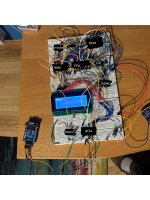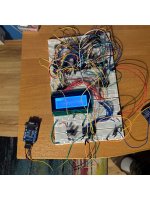Sendraz
Member
- Joined
- Apr 8, 2022
- Messages
- 16
Hello, i have currently almost built my project, which is a Z80 computer made from scratch on a breadboard with motorola 6850 ACIA with which i have a problem. It is connected to 1.8432 mhz crystal oscillator like the cpu, and i can send data with it from the z80 to the PC terminal, but when i send characters to the z80, it receives interrupt, but the received data is something like 11101101 in binary, or sometimes 00000000 depending on which character i input on my computer.
I dont have a proper schematics for this yet, but i have labeled where everything is on the photos, and i can describe how the ACIA is connected:
VCC - +5V
VSS - GND
RX_DATA - RxOut (rs232 to uart converter)
TX_DATA - TXin (rs232 to uart)
RX_CLK - 1.8432mhz crystal
TX_CLK - 1.8432mhz crystal
RTS - RTS (rs232 to uart)
IRQ - Z80 IRQ
CS0 - +5V
CS1 - +5V
CS2 - Y2 (74hc138 demultiplexer)
E - +5V
CTS - GND
DCD - GND
D0-D7 - D0-D7 (Z80)
R/W - WR (Z80)
The rs232 to uart is used temporarily, but with max232 + db9 connector it works the same.
I dont have a proper schematics for this yet, but i have labeled where everything is on the photos, and i can describe how the ACIA is connected:
VCC - +5V
VSS - GND
RX_DATA - RxOut (rs232 to uart converter)
TX_DATA - TXin (rs232 to uart)
RX_CLK - 1.8432mhz crystal
TX_CLK - 1.8432mhz crystal
RTS - RTS (rs232 to uart)
IRQ - Z80 IRQ
CS0 - +5V
CS1 - +5V
CS2 - Y2 (74hc138 demultiplexer)
E - +5V
CTS - GND
DCD - GND
D0-D7 - D0-D7 (Z80)
R/W - WR (Z80)
The rs232 to uart is used temporarily, but with max232 + db9 connector it works the same.




